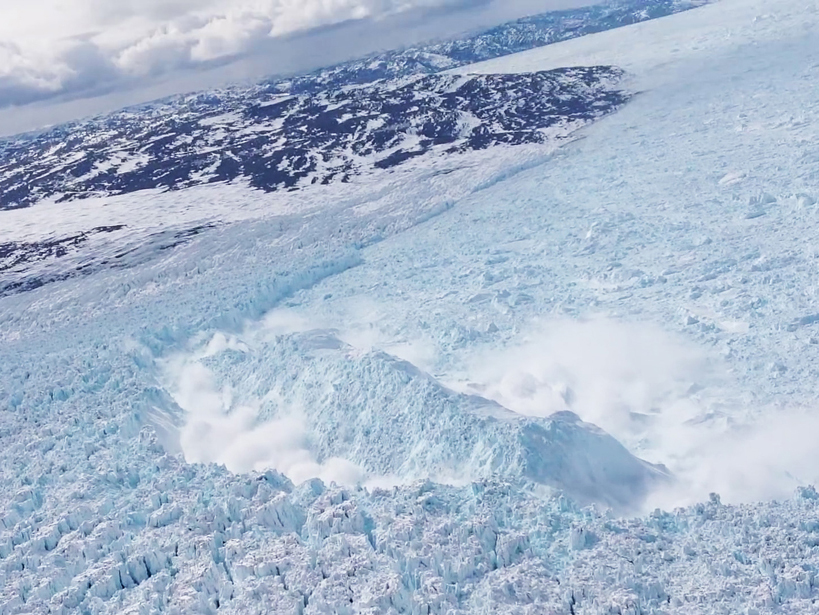Source: Geophysical Research Letters
As global temperatures rise, Earth’s polar regions face an existential threat—in Greenland, the ice sheet is thinning and marine-terminating glaciers are retreating. Perhaps the most dramatic element of this process is iceberg calving, which occurs when colossal masses of ice break away from a glacier and fall crashing into the sea.
Understanding the impact of iceberg calving is fundamental to our overall understanding of a warmer world: Calving impacts the longevity of ice sheets and contributes to the rise of global sea levels. Here Sergeant et al. calculated the forces behind a well-documented calving event on 21 August 2009 and compared their findings with video footage to analyze the seismic signals of calving mechanisms.
In Greenland, glacial earthquakes occur in marine-terminating glaciers when kilometer-scale ice blocks break away from the glacier and capsize. Buoyancy forces drive the overturning iceberg, scraping against the ocean floor and the face of the glacier, producing a long-lasting seismic signature. The team aimed to parse this signature and identify specific forces behind it.
The researchers analyzed seismic records from four broadband stations in Greenland—all between roughly 60 and 700 kilometers from the August 2009 calving event that took place at the terminus of the Jakobshavn Isbrae. The seismic stations were installed in Greenland as part of the Greenland Ice Sheet Monitoring Network (GLISN) project for detecting, locating, and characterizing cryoseismic phenomena and contribute to the understanding of ice sheet dynamics. They also used data from a temporary station located only 4 kilometers away, which also captured the 10-second images they assessed in combination with the seismic signal.
Variations in signal magnitude, duration, energy distribution, and frequency—between 0.01 and 3 hertz—enabled the researchers to identify four forces behind the event. The first was possibly an ice avalanche from the terminus into the fjord. This triggered movement in the ice mélange (the mixture of sea ice and previously calved icebergs), as well as the iceberg and snow that calving produces. A third distinct signal came from a bottom-out rotation, which occurs when an iceberg capsizes with the top moving toward the glacier front. The final signal picked up by the stations came from a top-out rotation of a second iceberg.
Between this inverted force analysis and the video footage, the researchers were able to pinpoint changes in force amplitude and direction over the course of the calving event, as well as new mechanisms behind the glacial seismicity. Exploring the source processes behind ice sheet collapse is fundamental to a better understanding of polar regions and the challenges they face as the global climate warms. (Geophysical Research Letters, doi:10.1002/2015GL066785, 2016)
—Lily Strelich, Freelance Writer
Citation: Strelich, L. (2016), Seismic clues reveal the mechanisms behind iceberg calving, Eos, 97, doi:10.1029/2016EO046123. Published on 16 February 2016.
Text © 2016. The authors. CC BY-NC 3.0
Except where otherwise noted, images are subject to copyright. Any reuse without express permission from the copyright owner is prohibited.

